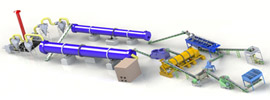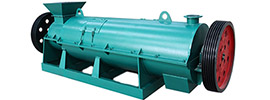Cattle farm manure management must balance environmental protection, resource utilization, and economic benefits while complying with local environmental regulations. Below is a scientific and systematic approach to manure treatment, combining the advantages, disadvantages, and application scenarios of different methods.
I. Core Management Principles
- Reduction: Optimize feed formulation (e.g., add enzymes to improve digestibility) and improve water systems (reduce leakage) to minimize manure production.
- Harmless Treatment: Eliminate pathogens and parasite eggs to prevent soil and water contamination.
- Resource Recovery: Convert manure into organic fertilizer, biogas, or biofuel for circular utilization.
II. Mainstream Treatment Methods and Implementation Guidelines
1. Composting (Most Common)
- Principle: Microbial decomposition of organic matter into stable humus.
- Steps:
- Pretreatment: Adjust moisture content (50%–60%) and C/N ratio (25:1–30:1) by adding straw or sawdust.
- Pile Construction: Windrow (2–3 m wide, 1.5–2 m high) or in-vessel composting (mechanical turning) to ensure aeration.
- Fermentation:
- Aerobic Composting: Turn piles every 3–5 days; maintain temperatures at 60–70°C for 5–7 days to kill pathogens.
- Anaerobic Composting: Seal piles to produce biogas (requires specialized equipment).
- Curing: Allow 2–3 months for stabilization before use.
- Advantages: Low cost, simple operation, safe end product.
- Disadvantages: Large land footprint, long cycle, labor-intensive.
- Application: Small- to medium-scale farms with adjacent farmland for fertilizer application.
2. Biogas Fermentation (Energy Recovery)
- Principle: Anaerobic microorganisms break down organic matter, producing biogas (60%–70% methane) and digestate (slurry/solid residue).
- Key Equipment:
- Biogas Digester: Concrete or glass-steel structure with insulation (critical for winter efficiency).
- Mixing System: Prevents stratification and enhances gas production.
- Desulfurization Unit: Removes hydrogen sulfide to protect pipelines.
- Operation:
- Feedstock Mixing: 70% cattle manure + 30% straw; adjust total solids (TS) to 8%–12%.
- Temperature Control: Mesophilic (35°C) or thermophilic (55°C) fermentation (the latter offers better sterilization).
- Regular Discharge: Digestate can be land-applied after dilution.
- Advantages: Energy generation (electricity/heating), reduced greenhouse gas emissions.
- Disadvantages: High initial investment, technical complexity, need for skilled maintenance.
- Application: Large-scale farms with energy demands or government subsidies.
3. Biological Treatment (High-Efficiency Resource Recovery)
- Black Soldier Fly (BSF) Farming:
- Principle: Insect larvae decompose manure into protein-rich biomass and organic fertilizer.
- Process: Pretreat manure (adjust moisture) → inoculate with eggs → harvest larvae after 2 weeks → separate residues.
- Advantages: Rapid processing, high-value outputs (larvae as animal feed).
- Disadvantages: Requires strict temperature (25–30°C) and humidity control; technical expertise needed.
- Vermicomposting:
- Principle: Earthworms consume manure, producing nutrient-rich vermicompost.
- Operation: Layer manure (10–15 cm) → introduce earthworms → periodically add feedstock and turn piles.
- Advantages: High-quality fertilizer, odorless.
- Disadvantages: Long cycle (3–6 months), vulnerable to predators.
4. Drying Treatment (Volume Reduction)
- Natural Drying: Sun-dry with rain/odor protection.
- Mechanical Drying:
- Rotary Drum: High-temperature rapid dehydration (energy-intensive).
- Solar Drying: Low-cost but weather-dependent.
- Advantages: Easy storage/transport.
- Disadvantages: Nutrient loss risk; spontaneous combustion hazard if not temperature-controlled.
III. Environmental Compliance Requirements
- Leakage Prevention: Line composting yards/digesters with geomembranes to protect groundwater.
- Odor Control:
- Cover piles with film/straw to reduce ammonia emissions.
- Install biofilters or spray deodorizers.
- Wastewater Management: Treat flushing water via sedimentation/anaerobic digestion before discharge or reuse.
- Mortality Disposal: Separate from manure; recommend high-temperature rendering or hygienic landfilling.
IV. Recommended Integrated Models
- Small Farms: Composting + digestate land application (paired with cropland).
- Large Farms: Biogas plant + biological treatment (BSF/earthworms) + organic fertilizer production.
- Arid Regions: Drying + pelletized fertilizer manufacturing.
By adopting scientific planning and tailored technologies, cattle farms can transform manure into valuable resources while mitigating environmental risks. Farms should select methods based on scale, budget, and technical capacity, and regularly monitor environmental indicators (e.g., COD, ammonia nitrogen) to ensure compliance.
 Send us a Email
Send us a Email Wulong Industrial Cluster
Wulong Industrial Cluster Have any question?
Have any question?



















